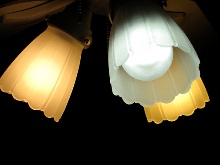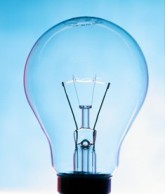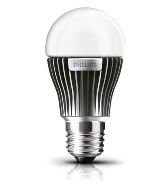Categories: Interesting electrical news, Electrician at home, Sources of light
Number of views: 66290
Comments on the article: 15
LED revolution: what is the advantage of LED lamps over incandescent lamps?
 Reason for switching to energy-saving LED products. Comparison and simple mathematical calculation of the savings and benefits of the purchase in the long run.
Reason for switching to energy-saving LED products. Comparison and simple mathematical calculation of the savings and benefits of the purchase in the long run.
Today, many talk about new energy-saving technologies. What's coming soon traditional “Ilyich’s bulbs” live out their Age and a new era is coming, or rather the electrical LED revolution.
This issue has risen to the state level. Starting with the President, who gave instructions to the state corporations Rosstekhnologii and Rusnano, to introduce energy-saving technologies, due to the fact that electricity is not used up efficiently and it is time to break stereotypes and keep up with the times. Factories will be built in a short time on the territory of Russia, where they will produce LED products and laboratories for their manufacture already exist, although they are very few and the cost is still high compared to LEDs from Asian countries.
What do modern technologies and the State in the person of these technologies offer us? What are the features led bulbs? And what are their advantages over ordinary incandescent lamps? Let’s try to look at it with our own eyes, without particularly going into politics and the production process, but look at the finished product through the eyes of consumers.
I will say right away that these products have been on the Russian market for several years. And this gave a wide response only when we all have echoes of the financial crisis. That the cost of energy is rising and often unreasonable. The state has finally paid attention to modern news. Although people who follow new technologies are always the first to start using them, taking advantage immediately, not expecting a drop in prices during the competition for customers, by this time, these people are already paying back their expenses. Yes, at an early stage this will seem like an expensive pleasure, but there are advantages and note that there are practically no disadvantages. But soon, you will understand and see, there are much more pluses and everything is accompanied by absolute benefit.
So, let's begin! We outline and compare our favorite incandescent bulbs and LED bulbs.
 Incandescent bulbs consume their designation plus five or seven percent loss. It turns out that a lamp that consumes 75 watts actually consumes 78 watts, or maybe more. In addition, only 95% of electricity is converted into heat and only 5% into light, this is a very small figure, moreover, this heat increases the risk of fire. A gradual evaporation of the tungsten wire quickly puts the bulb out of action, it also beats easily, and inside it is harmful substances. What can I say about new lamps that do not have flickering, but only uniform light, there are no harmful substances, and yet, they are very durable and practically do not heat up.
Incandescent bulbs consume their designation plus five or seven percent loss. It turns out that a lamp that consumes 75 watts actually consumes 78 watts, or maybe more. In addition, only 95% of electricity is converted into heat and only 5% into light, this is a very small figure, moreover, this heat increases the risk of fire. A gradual evaporation of the tungsten wire quickly puts the bulb out of action, it also beats easily, and inside it is harmful substances. What can I say about new lamps that do not have flickering, but only uniform light, there are no harmful substances, and yet, they are very durable and practically do not heat up.
Let's compare a 75W bulb with an analog of an LED lamp? What correspondence will be analogous, you think? I am sure you will be pleasantly surprised, only 10 watts. Almost 7.5 times less consumption, illumination is better, as well as efficiency. Also, lamps 40W = 5W and 15W = 120W, respectively, LED analogues.
The service life of an ordinary lamp is 1 year, but the LED is 5 years, but with a small caveat, if using it 10-12 hours a day, you can extend its service life to 12 years.
If these arguments are few, then I will show that I have in store for you. A complete mathematical and economic calculation that will complement your picture of the new generation of lamps and the fact that they will quickly pay for themselves.
 We take a period of 5 years, as much as a minimum, one LED light bulb will cost an average of 500 rubles - this is 10W.For the same period, we will need 50 incandescent lamps 75W at 8.5 rubles each and for 50 lamps it is 425 rubles. That is, one LED lamp will replace 50 ordinary ones. For the price and not such a big difference, you say: 500 and 425 rubles. (prices can vary, as well as the cost per 1 kW of electricity, but the calculation model is fair, you can calculate at different prices depending on the region, I took more or less relevant prices at the time of writing).
We take a period of 5 years, as much as a minimum, one LED light bulb will cost an average of 500 rubles - this is 10W.For the same period, we will need 50 incandescent lamps 75W at 8.5 rubles each and for 50 lamps it is 425 rubles. That is, one LED lamp will replace 50 ordinary ones. For the price and not such a big difference, you say: 500 and 425 rubles. (prices can vary, as well as the cost per 1 kW of electricity, but the calculation model is fair, you can calculate at different prices depending on the region, I took more or less relevant prices at the time of writing).
It seems like it is not convincing? We go further, we calculate the energy consumption, which the incandescent lamp and LED lamp will use for 5 years.
So, are you ready? 3750 kW, our ordinary light bulb eats so much and only 500 kW LED. Now we multiply these figures by the cost of 1 kW, my figure, at the moment it is 2.43 rubles. per kW, you have it, I repeat, it can change.
And what did we get? For 5 years, the energy consumption of an ordinary lamp is 9113-00 rubles. and only 1215-00 rubles. LED light.
We add the cost of buying lamps, plus the total cost of energy consumption, for the same 5 years.
The traditional lamp is 9538-00 rubles. and 1715-00 rubles. at the LED.
Now, it remains only to calculate how much savings we get when replacing one LED lamp?
And that is the figure ... are you ready? This figure is equal: 7823-00 rubles.
This treasured difference is 7.5 times, even with a slight plus, savings on purchases and energy costs.
Now you understand the value of contributing to the long term, that here you get only positive points. In any case, you decide, but do not forget that you will have to move over time to a new technological level. Indeed, a ban is introduced on incandescent lamps and thereby, they will gradually be withdrawn from circulation. This is one of the programs of the State policy in the field of electrotechnical prospects.
I hope that you have received comprehensive information and this article will inspire confidence in your choice or at least give a detailed picture of future prospects.
Read also on this topic: How to choose a LED lamp

See also at bgv.electricianexp.com
:
